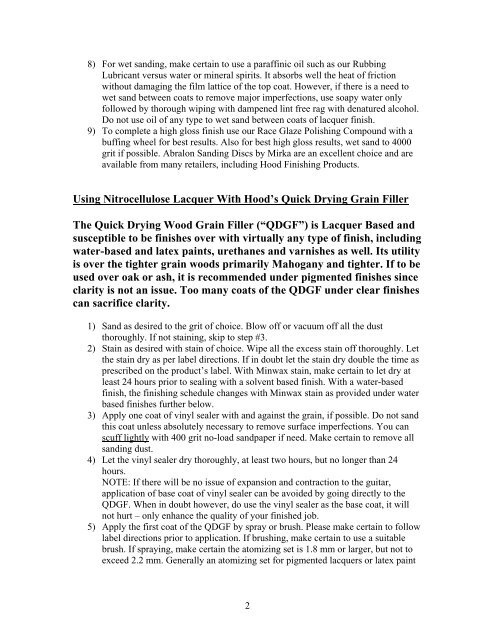Finishing Schedule On Acoustic Guitars - Kenneth Michael Guitars
Finishing Schedule On Acoustic Guitars - Kenneth Michael Guitars
Finishing Schedule On Acoustic Guitars - Kenneth Michael Guitars
You also want an ePaper? Increase the reach of your titles
YUMPU automatically turns print PDFs into web optimized ePapers that Google loves.
8) For wet sanding, make certain to use a paraffinic oil such as our Rubbing<br />
Lubricant versus water or mineral spirits. It absorbs well the heat of friction<br />
without damaging the film lattice of the top coat. However, if there is a need to<br />
wet sand between coats to remove major imperfections, use soapy water only<br />
followed by thorough wiping with dampened lint free rag with denatured alcohol.<br />
Do not use oil of any type to wet sand between coats of lacquer finish.<br />
9) To complete a high gloss finish use our Race Glaze Polishing Compound with a<br />
buffing wheel for best results. Also for best high gloss results, wet sand to 4000<br />
grit if possible. Abralon Sanding Discs by Mirka are an excellent choice and are<br />
available from many retailers, including Hood <strong>Finishing</strong> Products.<br />
Using Nitrocellulose Lacquer With Hood’s Quick Drying Grain Filler<br />
The Quick Drying Wood Grain Filler (“QDGF”) is Lacquer Based and<br />
susceptible to be finishes over with virtually any type of finish, including<br />
water-based and latex paints, urethanes and varnishes as well. Its utility<br />
is over the tighter grain woods primarily Mahogany and tighter. If to be<br />
used over oak or ash, it is recommended under pigmented finishes since<br />
clarity is not an issue. Too many coats of the QDGF under clear finishes<br />
can sacrifice clarity.<br />
1) Sand as desired to the grit of choice. Blow off or vacuum off all the dust<br />
thoroughly. If not staining, skip to step #3.<br />
2) Stain as desired with stain of choice. Wipe all the excess stain off thoroughly. Let<br />
the stain dry as per label directions. If in doubt let the stain dry double the time as<br />
prescribed on the product’s label. With Minwax stain, make certain to let dry at<br />
least 24 hours prior to sealing with a solvent based finish. With a water-based<br />
finish, the finishing schedule changes with Minwax stain as provided under water<br />
based finishes further below.<br />
3) Apply one coat of vinyl sealer with and against the grain, if possible. Do not sand<br />
this coat unless absolutely necessary to remove surface imperfections. You can<br />
scuff lightly with 400 grit no-load sandpaper if need. Make certain to remove all<br />
sanding dust.<br />
4) Let the vinyl sealer dry thoroughly, at least two hours, but no longer than 24<br />
hours.<br />
NOTE: If there will be no issue of expansion and contraction to the guitar,<br />
application of base coat of vinyl sealer can be avoided by going directly to the<br />
QDGF. When in doubt however, do use the vinyl sealer as the base coat, it will<br />
not hurt – only enhance the quality of your finished job.<br />
5) Apply the first coat of the QDGF by spray or brush. Please make certain to follow<br />
label directions prior to application. If brushing, make certain to use a suitable<br />
brush. If spraying, make certain the atomizing set is 1.8 mm or larger, but not to<br />
exceed 2.2 mm. Generally an atomizing set for pigmented lacquers or latex paint<br />
2


